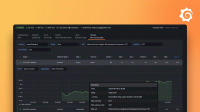Syntax
The Alloy syntax is easy to read and write. It has only two high-level elements, Attributes and Blocks.
The Alloy configuration syntax is a declarative language used to build programmable pipelines. The order of blocks and attributes within the Alloy configuration file isn’t important. The language considers all direct and indirect dependencies between elements to determine their relationships.
Comments
Alloy configuration files support single-line // and block /* */ comments.
Identifiers
Alloy syntax considers an identifier as valid if it consists of one or more UTF-8 letters (A through Z, both upper- and lower-case), digits or underscores, but doesn’t start with a digit.
Attributes and Blocks
Attributes
You use Attributes to configure individual settings.
They always take the form of ATTRIBUTE_NAME = ATTRIBUTE_VALUE.
They can appear either as top-level elements or nested within blocks.
The following example sets the log_level attribute to "debug".
log_level = "debug"The ATTRIBUTE_NAME must be a valid Alloy identifier.
The ATTRIBUTE_VALUE can be either a constant value of a valid Alloy type (for example, a string, boolean, number), or an expression to represent or compute more complex attribute values.
Blocks
You use Blocks to configure the Alloy’s behavior as well as Alloy components by grouping any number of attributes or nested blocks using curly braces. Blocks have a name, an optional label and a body that contains any number of arguments and nested unlabeled blocks.
Some blocks can be defined more than once.
Examples
You can use the following pattern to create an unlabeled block.
BLOCK_NAME {
// Block body can contain attributes and nested unlabeled blocks
IDENTIFIER = EXPRESSION // Attribute
NESTED_BLOCK_NAME {
// Nested block body
}
}You can use the following pattern to create a labeled block
// Pattern for creating a labeled block:
BLOCK_NAME "BLOCK_LABEL" {
// Block body can contain attributes and nested unlabeled blocks
IDENTIFIER = EXPRESSION // Attribute
NESTED_BLOCK_NAME {
// Nested block body
}
}Block naming rules
The BLOCK_NAME has to be recognized by Alloy as either a valid component name or a special block for configuring global settings.
If the BLOCK_LABEL must be set, it must be a valid Alloy identifier wrapped in double quotes.
In these cases, you use the label to disambiguate between multiple top-level blocks of the same name.
The following snippet defines a block named local.file with its label set to “token”.
The block’s body sets filename to the content of the TOKEN_FILE_PATH environment variable by using an expression, and the is_secret attribute is set to the boolean true, marking the file content as sensitive.
local.file "token" {
filename = env("TOKEN_FILE_PATH") // Use an expression to read from an env var.
is_secret = true
}Terminators
All block and attribute definitions are followed by a newline, which Alloy calls a terminator, as it terminates the current statement.
A newline is treated as a terminator when it follows any expression, ], ), or }.
Alloy ignores other newlines and you can enter as many newlines as you want.



